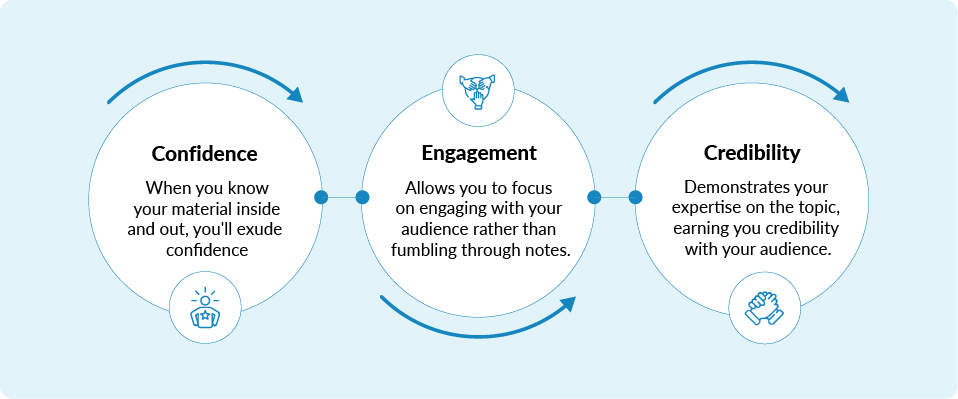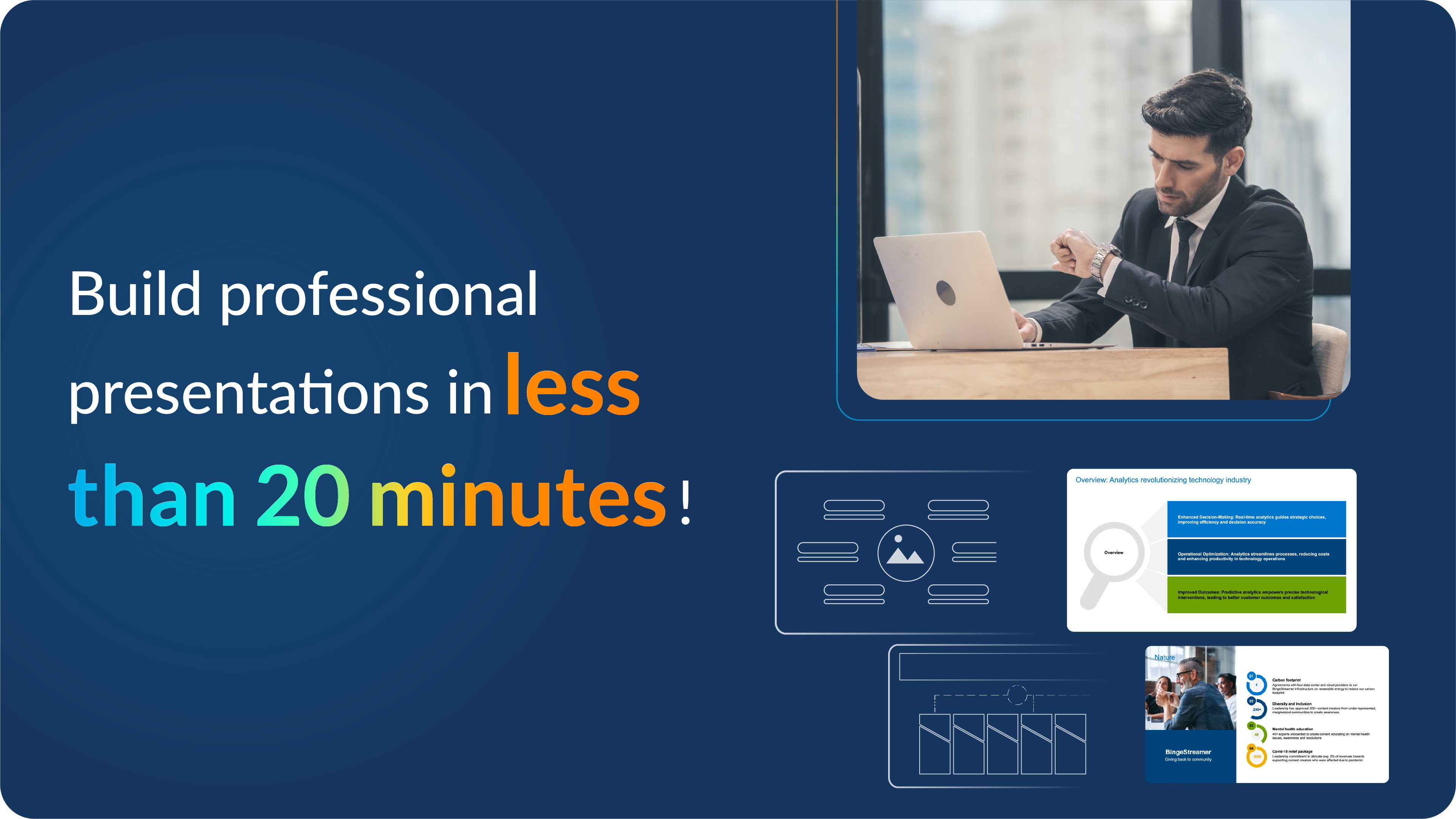How do you memorize a presentation? 13 effective ways to memorize your presentation material

So, you've got a big presentation coming up, and you want to nail it. But there's one thing standing in your way: memorization. Memorizing your presentation can seem like a daunting task, but fear not!
With the right techniques and presentation creation tools, you can commit your material to memory with ease and deal with the fear of public speaking.
Why should you memorize your presentation material?
Before looking into the how, let's first understand the why. Rehearse your presentation for several benefits:

Common mistakes during memorization of presentation
Now that we understand the importance of memorization, let's address some common pitfalls to avoid:
- Rote memorization: Simply repeating your presentation verbatim can lead to robotic delivery and hinder genuine connection with your audience.
- Over-reliance on slides: Relying too heavily on slides can impede memorization and cause you to lose your place if technical issues arise.
- Ignoring body language: Forgetting to incorporate body language cues into your memorization can make your delivery feel stiff and unnatural.
13 effective ways to help you remember your next presentation
Here are some effective techniques to ensure you deliver the speech or presentation with confidence and poise. Whether you're a seasoned professional or preparing for your first public speaking engagement, these strategies will enhance your preparation process and performance.
1. Understand your material
Before you even begin to memorize your presentation, it's crucial to have a deep understanding of your material. Break down your content into key concepts and frame it like a story with a good flow. This isn't just about remembering words but grasping the essence of what you're going to talk about. Relate these concepts to stories or experiences for easier recall.
After breaking down the content and relating it to personal experiences, map out a narrative arc for your presentation. What are the key points? How does one idea flow into the next? This will not only help you remember the order of your content, but it will also make your presentation more engaging.
2. Employ the memory palace technique
The loci method, or memory palace technique, involves associating parts of your presentation with specific physical locations. By visualizing a familiar place and 'placing' elements of your talk in different locations within this space, you can walk through the area in your mind to help recall information.
Example: For a presentation on the impact of regular exercise, assign each key point to a room in your house using the mind palace technique:
- Front door (Introduction): Envision stepping over a jump rope to enter, setting the stage for discussing the importance of physical activity.
- Kitchen (Benefits): Picture a basket of fresh fruits on the counter, symbolizing the health benefits of exercise, like improved heart health and energy levels.
- Living room (Strategies): Imagine a treadmill and yoga mat, representing strategies to incorporate exercise into daily life.
This concise setup creates a mental journey through your presentation, helping you recall each part clearly during delivery.
3. Create mind maps
It is a powerful tool for organizing your thoughts and ideas visually. By creating a mind map of your presentation, you can see the relationships between different sections and points. This visual representation makes it easier to memorize the flow of your presentation and recall details during your delivery.
Not only does a mind map provide a clear picture of your content structure, but it also encourages creativity. Essentially, it's brainstorming amplified. By the end, you are left with a rich tree of thoughts and ideas - your complete presentation, written out in an easy-to-follow map. So, next time you are preparing for a presentation, take a moment. Create a mind map.
4. 20-20-20 rule
The 20-20-20 rule of rehearsal is simple and very effective. Every 20 minutes, take a 20-second break and look at something 20 feet away to prevent eye strain and maintain focus. This technique helps not only to rest your eyes but also to refocus your mind. It's a moment to breathe, to recalibrate, to reassess.
You'll find that when you return to your task, quite often you’ll approach it with a renewed sense of clarity. And guess what? It won't derail your productivity, it will enhance it. So, set your timer, practice the 20-20-20 rule, and see the difference it makes.
5. Practice... a lot!
There's no substitute for practice. The power to influence, inspire, and inform an audience lies in your ability to confidently present your material. Rehearsing your presentation multiple times is an absolute necessity. Each rehearsal should focus on refining different aspects - from your tone of voice to your body language.
Try practicing in front of a mirror. Watch your facial expressions and movements - do they align with the message you're trying to convey?
Don’t shy away from presenting to a friend or colleague. They can offer valuable feedback that you might overlook. Their perspective can help you pinpoint areas for improvement - from your content clarity to your engagement skills.
6. Use mnemonic devices
Mnemonic devices are shortcuts to help you remember information more easily. Create acronyms, phrases, or even songs that are related to the content of your presentation. These tools are particularly useful for memorizing lists or complex information. Example -
- Acronyms: Suppose your deck is about the critical components of a successful team. You could use the acronym "G.R.I.T." to help remember and convey these components: Goal-oriented, Resilient, Interpersonal skills, and Tenacity. Each letter prompts you to recall and discuss each characteristic in detail.
- Phrases: For a deck on the stages of project management, you might use a catchy phrase like "Dogs Prefer Running Through Water" to memorize the stages: Define, Plan, Run, Track, and Wrap-up. This phrase creates a visual and auditory mnemonic that makes the stages easier to remember and recite.
7. Chunk your information
Rather than attempting to engulf the entirety at once, take it bit by bit. Start with the introduction. Then the first key point. Followed by the next. Revisit each segment, solidifying your grasp before proceeding. This piecemeal approach fosters understanding and retention.
Now apply this tactic in a broader context. Imagine the potential improvement in processing complex instructions, studying for a crucial exam, or even mastering a new skill. Chunking is not just for presentations. It's a powerful tool in our cognitive arsenal to improve productivity and efficiency, providing an antidote to the overwhelm of big tasks. Take it step-by-step.
8. Incorporate physical movement
Our bodies and minds are interconnected. Using gestures or physical movements while assembling your presentation could be your game-changer. The theory is simple: associate different elements of your speech with specific movements. This technique is rooted in the idea of muscle memory - your body remembers.
For example, try pointing up when discussing quarterly growth, or stride across the room when talking about overcoming challenges. The physical act of moving can help reinforce your material, making it easier to recall during the presentation.
9. Take advantage of technology
Use apps and tools designed to improve memorization and practice. From presentation software with storybuilder features to flashcard apps that help you drill main points, technology can be a valuable ally in your preparation. You can even record your presentation to check how it looks.
10. Teach someone else
Teaching someone else about your presentation content is not just a rehearsal; it's a powerful learning technique known as the "Protégé Effect." This strategy is grounded in the principle that teaching information to another person improves the teacher's own understanding and retention of the material. When you explain concepts to someone else, you are forced to clarify your thoughts, identify any gaps in your own knowledge, and think about the material in new and different ways.
11. Stay healthy
The adage "a healthy body houses a healthy mind" is more than just a saying; it's backed by extensive scientific research. The interconnection between physical health and mental acuity cannot be overstated. A good night's sleep, proper nutrition, and regular exercise are foundational elements that support cognitive functions, including memory, attention, and problem-solving skills.
Did you know - A study from the University of British Columbia found that regular aerobic exercise, the kind that gets your heart and your sweat glands pumping, appears to boost the size of the hippocampus, the brain area involved in verbal memory and learning.
12. Visualize success
Visualizing success, particularly in the context of preparing for a presentation, is a powerful technique rooted in cognitive psychology. This practice involves creating a detailed mental image of achieving a desired outcome, including feeling confident and engaging your audience effectively during a presentation.
The science behind visualization is based on the principle that the brain and nervous system respond similarly to imagined experiences as they do to real experiences. This means that by visualizing success, you can condition your mind and body to perform more effectively in the actual situation.
13. Reflect and adjust
Reflecting on and adjusting your approach after each practice session is a critical part of mastering any skill, including memorization and presentation delivery. This iterative process is grounded in the principles of deliberate practice and reflective learning, which are key to achieving expertise in any field.
An example of the reflect and adjust method in action can be seen in medical education, where students often engage in simulated patient interactions. After each simulation, students reflect on their performance, receive feedback from instructors, and identify specific areas for improvement. This process has been shown to significantly improve students' diagnostic accuracy and patient communication skills over time.
What to do if you forget a main point midway?
Even with thorough preparation, forgetting a part of your presentation can happen. If you find yourself drawing a blank mid-speech, take a deep breath, and try one of these strategies to remember your presentation:

FAQs
1. How long does it take to memorize a presentation?
Memorization time varies depending on the length and complexity of the presentation, but consistent practice can significantly reduce the time required.
2. Is it okay to use cue cards during a presentation?
While cue cards can be helpful for reference, relying too heavily on them can hinder your connection with the audience. Aim to minimize their use through thorough memorization and practice.
3. Should I memorize every word of my presentation?
While it's essential to have a thorough understanding of your material, aiming for word-for-word memorization can lead to robotic delivery. Focus on memorizing key points and transitions for a more natural presentation.
4. What if I make a mistake during my presentation?
Mistakes are natural and happen to everyone. Take a deep breath, acknowledge the error gracefully, and continue with your presentation. Your ability to recover smoothly can even enhance your credibility with the audience.
5. How can I calm my nerves before a presentation?
Practice relaxation techniques such as deep breathing, visualization, and positive affirmations to calm pre-presentation nerves and boost your confidence.
Ways in which Prezent can help you memorize!
Prezent is a comprehensive AI-powered platform designed to enhance the effectiveness and efficiency of your presentations, making it easier for you to memorize and deliver them with confidence.
Simplification of complex information:
Generative AI: Converts complex sentences into clear, concise presentations. This feature helps in breaking down intricate ideas into simpler, more memorable pieces.
Executive summary synthesis: Converts detailed decks into a one-page summary, focusing on the essence of the presentation. This aids in grasping and remembering the core message.
Engaging storytelling:
Structured storylines: Utilizes AI to help structure presentations in a narrative format, making the information more engaging and easier to remember.
Access to 35,000+ brand-approved slides: Offers a vast library that can be used to create visually appealing and narrative-driven presentations, enhancing the storytelling aspect.
Efficiency in presentation creation:
Personalized on-brand presentations in seconds: Quickly generates presentations that align with brand guidelines, saving time and allowing presenters to focus more on the content's delivery and memorization.
Story-builder tool: Streamlines the creation process by providing a structured framework for presentations, reducing the time spent on design and layout.
Visual aids for enhanced recall:
Redesign to brand-new look: Instantly transforms slides into visually appealing formats that are consistent with brand identity, making the visual aids more memorable.
Library of curated best-practice presentations: Offers access to high-quality visual and content templates that enhance the visual appeal and recallability of presentations.
Adaptive training and learning modules:
On-demand learning modules: Provides modules on the art and science of business communication, including effective use of visual aids and storytelling, which can improve presentation skills.
Communication fingerprints: A unique feature that helps understand personal or audience preferences, enabling the creation of more personalized and impactful presentations that are easier to remember.
Remember, creating a presentation that is as visually compelling as the information it contains will elevate your confidence, making your delivery in front of a large audience seamless and powerful.
Explore Prezent with a free trial to create such stunning presentations. Schedule a demo to experience all the product features and how it can elevate your presentations.
.avif)











